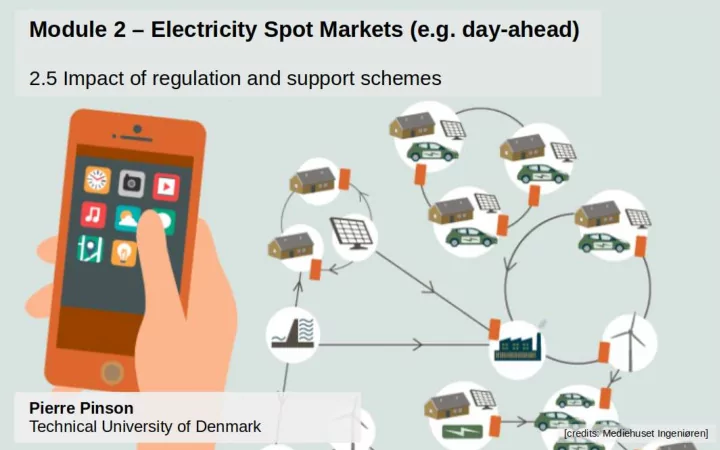

Why regulation and support schemes? New energy generation technologies may need support in order to reach grid parity (i.e., when Levelized Cost of Energy - LCOE, becomes less than market price) Regulation is then an instrument for policy makers to support their integration in the market Support schemes consist in financial support to make them competitive in the market 2/9
Alternative support schemes The 3 most common support schemes are: feed-in-tariff (FIT) fixed feed-in premium (FIP) contract for difference (CfD, or sliding premium) These may have an impact on participant revenues, offering strategies and market outcomes 3/9
Participant revenues Let us consider the case of a renewable energy producer (wind or solar) participating in the Danish day-ahead electricity market, DK1 area (Western Denmark) 3 cases: FIT at 35 e /MWh FIP of 5 e /MWh CfD to guarantee 35 e /MWh Revenues are: FIT case: 35 × 3 = 105 e FIP case: (23+16+32) + 5 × 3 = 96 e CfD case: (23+16+32) + (12+19+3) = 105 e 4/9
Offering strategies under CfD support scheme Consider a wind or solar power producer under a CfD support scheme 5/9
Offering strategies under CfD support scheme Consider a wind or solar power producer under a CfD support scheme The optimal offering strategy is to offer at minimum price, e.g., -500 e /MWh in Nord Pool 5/9
Offering strategies under FIP scheme Consider the same wind or solar power producer under a FIP support scheme 6/9
Offering strategies under FIP scheme Consider the same wind or solar power producer under a FIP support scheme The optimal offering strategy is to offer at minus the FIP value, e.g., -5 e /MWh in the present case 6/9
Effect on market outcomes Let us see the effect of having more or less market participants with different support schemes Only a few of them Quite many more As their share increase, clearing prices can become negative(!) 7/9
Impact of a change of regulation on the market The regulator states that if clearing prices are negative, market participants lose their support (CfD and FIP) For both support scheme, the optimal strategy is then to offer at 0 e /MWh 8/9
Impact of a change of regulation on the market The regulator states that if clearing prices are negative, market participants lose their support (CfD and FIP) For both support scheme, the optimal strategy is then to offer at 0 e /MWh Quite many more Only a few of them Clearing prices still decrease, but they never become negative 8/9
Recommend
More recommend